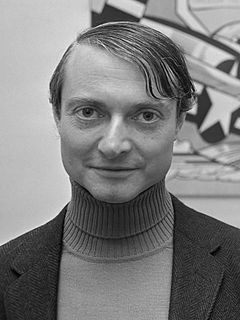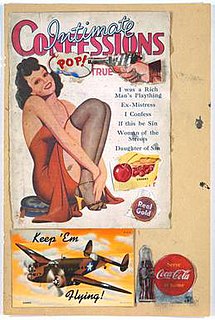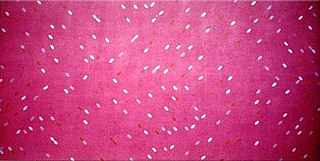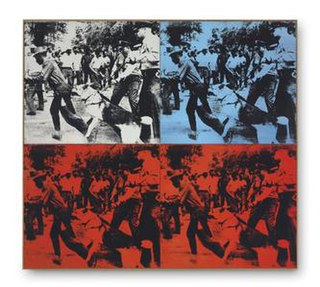
Andy Warhol was an American artist, film director, and producer who was a leading figure in the visual art movement known as pop art. His works explore the relationship between artistic expression, advertising, and celebrity culture that flourished by the 1960s, and span a variety of media, including painting, silkscreening, photography, film, and sculpture. Some of his best known works include the silkscreen paintings Campbell's Soup Cans (1962) and Marilyn Diptych (1962), the experimental films Empire (1964) and Chelsea Girls (1966), and the multimedia events known as the Exploding Plastic Inevitable (1966–67).

Roy Fox Lichtenstein was an American pop artist. During the 1960s, along with Andy Warhol, Jasper Johns, and James Rosenquist among others, he became a leading figure in the new art movement. His work defined the premise of pop art through parody. Inspired by the comic strip, Lichtenstein produced precise compositions that documented while they parodied, often in a tongue-in-cheek manner. His work was influenced by popular advertising and the comic book style. His artwork was considered to be "disruptive". He described pop art as "not 'American' painting but actually industrial painting". His paintings were exhibited at the Leo Castelli Gallery in New York City.

Pop art is an art movement that emerged in the United Kingdom and the United States during the mid- to late-1950s. The movement presented a challenge to traditions of fine art by including imagery from popular and mass culture, such as advertising, comic books and mundane mass-produced objects. One of its aims is to use images of popular culture in art, emphasizing the banal or kitschy elements of any culture, most often through the use of irony. It is also associated with the artists' use of mechanical means of reproduction or rendering techniques. In pop art, material is sometimes visually removed from its known context, isolated, or combined with unrelated material.

James Rosenquist was an American artist and one of the proponents of the pop art movement. Drawing from his background working in sign painting, Rosenquist's pieces often explored the role of advertising and consumer culture in art and society, utilizing techniques he learned making commercial art to depict popular cultural icons and mundane everyday objects. While his works have often been compared to those from other key figures of the pop art movement, such as Andy Warhol and Roy Lichtenstein, Rosenquist's pieces were unique in the way that they often employed elements of surrealism using fragments of advertisements and cultural imagery to emphasize the overwhelming nature of ads. He was a 2001 inductee into the Florida Artists Hall of Fame.

Robert Indiana was an American artist associated with the pop art movement. His "LOVE" print, first created for the Museum of Modern Art's Christmas card in 1965, was the basis for his 1970 Love sculpture and the widely distributed 1973 United States Postal Service "LOVE" stamp. He created works in media including paper and Cor-ten steel.

Leo Castelli was an Italian-American art dealer. His gallery showcased contemporary art for five decades. Among the movements which Castelli showed were Surrealism, Abstract Expressionism, Neo-Dada, Pop Art, Op Art, Color field painting, Hard-edge painting, Lyrical Abstraction, Minimal Art, Conceptual Art, and Neo-expressionism.
Tony Shafrazi, is an American art dealer, gallery owner and artist. He is the owner of the Shafrazi Art Gallery in New York City, who deals artwork by artists such as Francis Bacon, Keith Haring, and David LaChapelle.

Campbell's Soup Cans is a work of art produced between November 1961 and March or April 1962, by American artist Andy Warhol. It consists of thirty-two canvases, each measuring 20 inches (51 cm) in height × 16 inches (41 cm) in width and each consisting of a painting of a Campbell's Soup can—one of each of the canned soup varieties the company offered at the time. The non-painterly works were produced by a screen printing process and depict imagery deriving from popular culture and belong to the pop art movement.

Ronald "Ron" Davis, is an American painter whose work is associated with Geometric abstraction, Abstract Illusionism, Lyrical Abstraction, Hard-edge painting, Shaped canvas painting, Color field painting, and 3D Computer Graphics. He is a veteran of nearly seventy solo exhibitions and hundreds of group exhibitions.
Ileana Sonnabend was a Romanian-American art dealer of 20th-century art. The Sonnabend Gallery opened in Paris in 1962 and was instrumental in making American art of the 1960s known in Europe, with an emphasis on American Pop Art. In 1970, Sonnabend Gallery opened in New York on Madison Avenue and in 1971 relocated to 420 West Broadway in SoHo where it was one of the major protagonists that made SoHo the international art center it remained until the early 1990s. The gallery was instrumental in making European art of the 1970s known in America, with an emphasis on European conceptual art and Arte Povera. It also presented American conceptual and minimal art of the 1970s. In 1986, the so-called “Neo-Geo” show introduced, among others, the artist Jeff Koons. In the late 1990s, the gallery moved to Chelsea and continues to be active after Sonnabend's death. The gallery goes on showing the work of artists who rose to prominence in the 1960s and 1970s like Robert Morris, Bernd and Hilla Becher and Gilbert & George as well as more recent artists like Jeff Koons, Rona Pondick, Candida Höfer, Elger Esser, and Clifford Ross among others.

Michael Bidlo is an American conceptual artist who employs painting, sculpture, drawing, performance, and other forms of "social sculpture."
Peter Young is an American painter. He is primarily known for his abstract paintings that have been widely exhibited in the United States and in Europe since the 1960s. His work is associated with Minimal Art, Post-minimalism, and Lyrical Abstraction. Young has participated in more than a hundred group exhibitions and he has had more than forty solo exhibitions in important contemporary art galleries throughout his career. He currently lives in Bisbee, Arizona.

Lawrence M. "Larry" Poons is an American abstract painter. Poons was born in Tokyo, Japan, and studied from 1955 to 1957 at the New England Conservatory of Music, with the intent of becoming a professional musician. After seeing Barnett Newman's exhibition at French and Company in 1959, he gave up musical composition and enrolled at the School of the Museum of Fine Arts, Boston. He also studied at the Art Students League of New York. Poons taught at The Art Students League from 1966–1970 and currently teaches at the League.
Richard Ernst Artschwager was an American painter, illustrator and sculptor. His work has associations with Pop Art, Conceptual art and Minimalism.
The OK Harris Gallery was an art gallery located at 383 West Broadway in SoHo, New York City. The gallery closed in 2014. Founded by longtime art dealer Ivan Karp after leaving the Leo Castelli gallery in 1969 where he had worked as gallery co-director for nearly 10 years. Karp opened his own gallery called the OK Harris Gallery in SoHo.
David Whitney was an American art curator, collector, gallerist and critic. He led a very private life and was not well known outside the art world, even though he participated naked in the 1965 Claes Oldenburg happening Washes. He was the life partner of architect Philip Johnson (1906–2005) for 45 years until their deaths five months apart. He was also a close friend of Andy Warhol.

Look Mickey is a 1961 oil on canvas painting by Roy Lichtenstein. Widely regarded as the bridge between his abstract expressionism and pop art works, it is notable for its ironic humor and aesthetic value as well as being the first example of the artist's employment of Ben-Day dots, speech balloons and comic imagery as a source for a painting. The painting was bequeathed to the Washington, D.C., National Gallery of Art upon Lichtenstein's death.
Ivan C. Karp was an American art dealer, gallerist and author instrumental in the emergence of pop art and the development of Manhattan's SoHo gallery district in the 1960s.

Race Riot is an acrylic and silkscreen painting by the American artist Andy Warhol that he executed in 1964. It fetched $62,885,000 at Christie's in New York on 13 May 2014.
Virgil Marti is an American visual artist recognized for his installations blending fine art, design, and decor from a range of styles and periods. Marti’s immersive sculptural environments, often evoking nature and the landscape, combine references from high culture with decorative, flamboyant, or psychedelic imagery, materials, and objects of personal significance.












